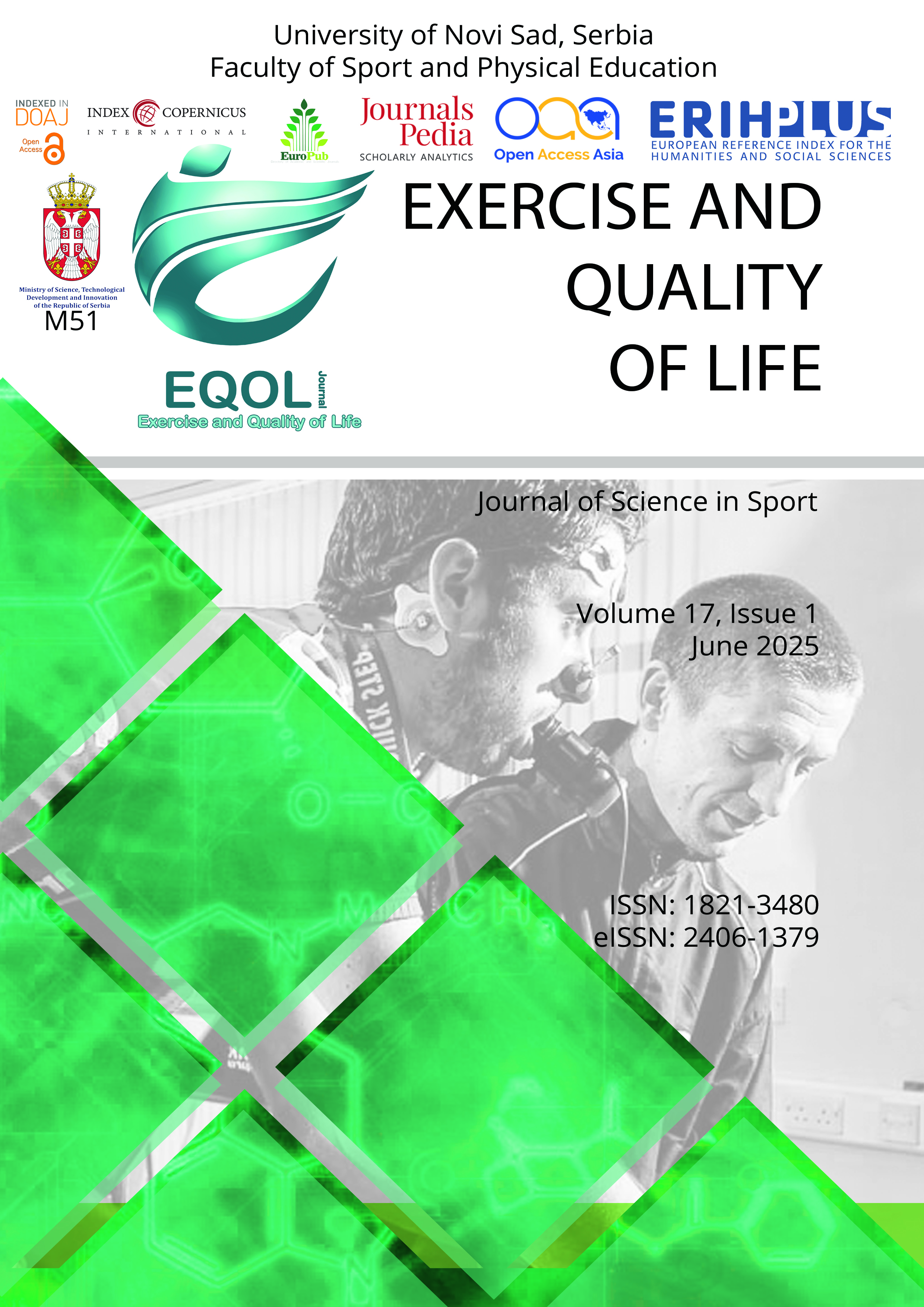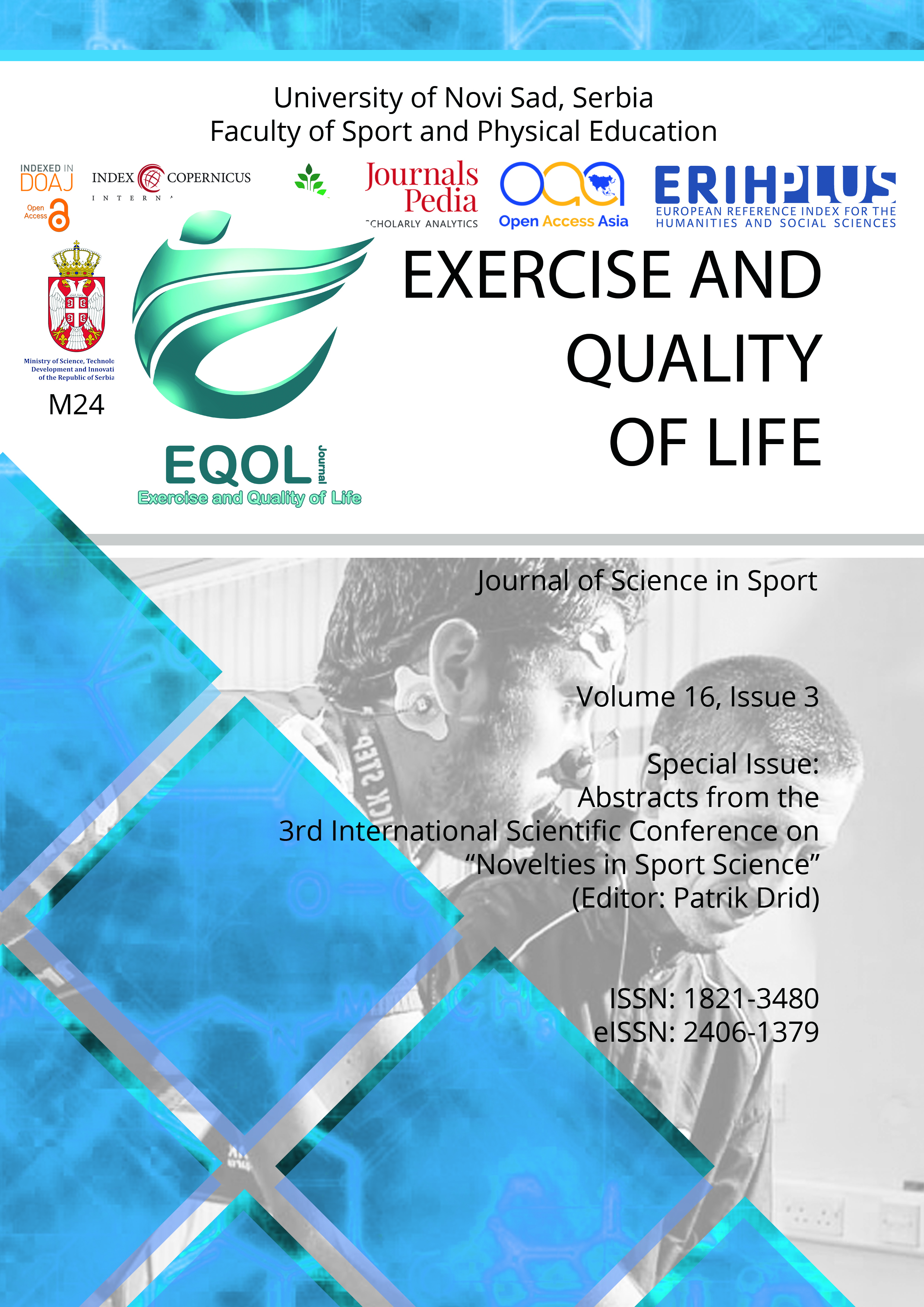Current issue

Volume 17, Issue 1, 2025
Online ISSN: 2406-1379
ISSN: 1821-3480
Volume 17 , Issue 1, (2025)
Published: 15.06.2025.
Open Access
All issues
Contents
02.05.2025.
Original scientific paper
Interdependence of neck pain prevalence with neck disability and sleep quality among Nigerian seamstresses
Seamstresses, due to the nature of their profession, often face ergonomic challenges stemming from prolonged sitting, repetitive motions, and the adoption of awkward postures. These factors could affect sleep quality and contribute to an increased risk of musculoskeletal disorders, including but not limited to, carpal tunnel syndrome, neck and back pain, and shoulder strain. It seems necessary, therefore, to evaluate the association of neck pain prevalence with neck disability and sleep quality among Nigerian seamstresses. 169 participants of ages 18 and above with varying levels of experience were recruited using a convenience sampling technique. The measure employed has 4 sections containing socio-demographics, Nordic Musculoskeletal Questionnaire, the Sleep Quality aspect of the Pittsburgh sleep quality index and Neck Disability Index. Descriptive statistics such as frequencies, and percentages were used to summarize the data and provide an overview of the respondents’ prevalence of neck pain. Pearson’s Chi square was used to test the association of neck pain prevalence with sleep quality and neck disability at 0.05 alpha level. The lifetime and 12-month prevalence of neck pain were 83.4% and 73.4% respectively. 39 (23.1%) reported good sleep quality. About 45.6% of the respondents’ reported no neck disability. There is no statistically significant relationship between neck disability and the prevalence of neck pain (X2 = 6.416, p = 0.601). However, a significant relationship was observed between the prevalence of neck pain and sleep quality (X2= 4.411, p = 0.036). Seamstresses have a high prevalence of neck pain due to long hours of static positions. Poor sleep quality was also associated with neck pain. Nonetheless, there was no significant relationship between neck disability and pain prevalence, although, sleep quality, pain intensity, and neck disability are interconnected in the present study.
Jehurat Abdulahi, Adebisi Hammed, Nicholas Oghumu, David Akintayo, Solomon Ogbouma, Martins Okhawere, Imuwahen Mbarie, Ayobami Fasuba, Kayode Oke
02.04.2025.
Original scientific paper
Enhancing quality of life through physical exercise in a patient with triple lumbar disc herniation: A longitudinal case study
Lumbar disc herniation, a growing condition, significantly impacts work productivity, mental health, and quality of life. It alters functional movement patterns and causes improper compensatory body positioning, leading to muscle dysfunction. Physical exercise is a key treatment for chronic cases. This case study examined a 37-year-old male with moderate triple lumbar disc herniation and degenerative disc changes at L3-L4, L4-L5, and L5-S1. The subject followed a 10-week home-based exercise program performed 4 to 5 times weekly for 45 minutes per session. The program consisted of variations of body-weight exercises, supplemented with additional equipment, and progressively increased in intensity and volume, targeting hip joint mobility and strengthening of deep back, abdominal, and thigh muscles. Initial and final assessments included the Pain Detect test, the Short Form Health Survey-36 on quality of life, Manual Muscle Testing (MMT), Functional Movement Screen (FMS), and body composition analysis. Questionnaires indicated significant pain reduction and improvements in physical condition and psychosocial well-being. MMT improved from 4 to 5, FMS from 2 to 3, and body composition showed positive changes: weight (+1.5%), body water (+3.4%), skeletal muscle (+2.8%), and body fat (-6.6%). The subject reported substantial pain reduction, improved physical condition and psychosocial well-being, as well as enhanced muscle strength, functional movement patterns, and body composition. This case study highlights the program’s effectiveness in treating lumbar disc herniation and enhancing quality of life. Additionally, the program is suitable for preventing lumbar disc herniation and improving overall quality of life in the broader population.
Kristina Randow de Almeida, Marko Kapeleti, Vuk Stevanović, Vladimir Mrdaković, Marija Macura
22.04.2025.
Review scientific paper
Blood flow restriction endurance exercise and endurance performance in athletes
The development and advancement of sports training over time have been accompanied by continuous innovations, which significantly contribute to improving athletic performance. In this process, research has played a crucial role in understanding the effectiveness of various training methods, including blood flow restriction (BFR) exercise, which is increasingly gaining attention due to its potential to enhance athletic performance. BFR training can be implemented in both: resistance exercise and endurance exercise. The studies discussed indicate a growing interest in the application of BFR through endurance type of exercise to enhance aerobic capacity.
This narrative review examined the role of BFR training in enhancing endurance performance by reviewing relevant literature. We performed a comprehensive search on PubMed and Google Scholar using keywords such as “Blood Flow Restriction”, “endurance exercise”, “aerobic capacity”, and “athletes”. The focus was on peer-reviewed articles published in the last decade that investigated the effects of BFR training on endurance and aerobic capacity, specifically within athletic populations. Studies included in this review were selected based on their relevance to BFR training and its impact on endurance performance, while those not directly related to BFR or involving non-athlete populations were excluded. Key findings concerning BFR training protocols and their impact on endurance metrics were summarized. This review aims to provide an overview of the current evidence regarding the effectiveness of BFR training in endurance exercise and its potential implications for optimizing athletic performance.
These investigations adopting BFR training show promising results, with several studies reporting significant improvements in key physiological parameters such as maximal oxygen consumption (VO2 max) and muscular endurance.
Overall evidence suggests that integrating BFR training into endurance exercise training regimens holds potential for optimizing aerobic capacity in athletes.
Matevž Arčon, Nejc Črnčič
27.04.2025.
Original scientific paper
The impact of exercise habits on quality of life among emergency medicine physicians: A cross-sectional study
Physician quality of life is a critical factor influencing overall health, wellness, occupational stress, and burnout. Exercise has been demonstrated to enhance quality of life through multiple mechanisms, positively impacting physical, psychological, and social health domains. The objective of this study was to examine the exercise habits of emergency medicine physicians and their association with quality of life. A quantitative, non-experimental, cross-sectional design was employed to study 103 attending emergency medicine physicians. Participants completed an online questionnaire comprising the International Physical Activity Questionnaire (IPAQ) and the World Health Organization Quality of Life BREF (WHOQOL-BREF) survey to assess physical activity levels and quality of life, respectively. There was no significant difference between compliance with moderate and vigorous physical activity and quality of life across domains. However, strength training compliance was statistically significant (p = 0.041) and correlated with improved physical health and quality of life scores. Quality of life among this cohort was slightly elevated in the physical health domain but lower in psychological, social, and environmental health domains compared to population averages. Furthermore, age and the number of hours worked per week were not statistically different in any quality of life domains. Exercise compliance among emergency physicians showed no statistically significant impact on quality of life, except for strength training, which was found to significantly enhance the physical health domain of quality of life.
Gregory Gibbons, Aaron Aslakson, Bridget Melton, Helen Bland
23.01.2025.
Original scientific paper
Acute effects of half-marathon and aronia juice on lipid and hematological parameters, muscle function and oxidative status in male runners
The present cross-over study investigated whether a half-marathon race might impose changes in lipid profile, muscle function, hematological parameters, and oxidative status in 10 amateur male runners and whether polyphenol-rich aronia juice may counteract these potential alterations.
Subjects (age 30.8 ± 2.3 years) ran a simulated half-marathon race (21.1 km), after they had consumed breakfast with 200 mL of aronia juice/placebo on two occasions separated by one week. Blood samples were taken at baseline, 15 min, 1 h, and 24 h after the run.
Results revealed a significant increase in the levels of total, LDL cholesterol, and triglycerides immediately after the run (by 6.97%, 9.23%, and 38.46%, respectively), which tended to return to the baseline values after 24 hours. The activity of lactate dehydrogenase increased significantly after the race and started decreasing 24h after the race, still being 16.18% higher compared with the baseline. The run induced a marked increase in total number of leukocytes, and granulocytes, with an eventual return to the baseline levels.
The obtained results suggest that a half-marathon run is intense enough to cause lipid mobilization, muscle damage and compromise the immune response in recreational male runners. Acute aronia juice intake was not sufficient to attenuate the observed changes.
Ana Pantović, Vuk Stevanović, Irena Krga, Marija Takić, Nevena Vidović
22.01.2025.
Original scientific paper
Comparison of the effects of isoinertial and traditional strength training in male tennis players
The goal of the research was to determine the effects of six weeks of isoinertial training on explosive strength, speed, and agility compared to traditional strength training in tennis players. The subjects, thirty male tennis players aged 20 to 35, were divided into three groups: the experimental group 1 (E1; n=10), which performed strength training on an isoinertial device; the experimental group 2 (E2; n=10), which performed traditional strength training; and the control group (C1; n=10). E1 and E2 groups had a total of six weeks of training with two training sessions per week, with three exercises per training session performed in four series for six to eight repetitions. The results showed that isoinertial strength training has a positive effect in the variables squat jump (SJ), countermovement jump (CMJ), 5-meter sprint (5M), 20-meter sprint (20M), agility T-test (T-test), and 505 agility test (505). Post hoc analysis revealed that there are significantly better effects of isoinertial training compared to isodynamic training in the countermovement jump (CMJ), 5-meter sprint (5M), and 20-meter sprint (20M). The E1 group had significantly better results than the C1 group in all tests. The E2 group had significantly better results compared to the C1 group in the variables SJ, 20M, and T-test. The results also show that six weeks of isoinertial training produce better results in the development of variables CMJ and 20M compared to the traditional strength training group. Accordingly, fitness and tennis coaches should also use this training method when working with tennis players.
Dušan Ćorilić, Boris Karasek, Mladen Mikić
20.01.2025.
Original scientific paper
Characteristics of the Health-Related Physical Fitness Questionnaire: Serbian version
Modern directions in the development of physical education in the world emphasize the importance of health-related physical fitness (HRPF), with special attention to the development and monitoring of knowledge about HRPF through the application of a targeted questionnaire. The main goal of this research was to analyze the characteristics of the HRPF questionnaire adapted to the Serbian language. After adjustment to Serbian language and terminology, questionnaire was administered to a sample of 270 children, 175 children of the fifth grade (11 to 12 years) and 95 children f the eighth grade (14 to15 years). In both subsamples, the questionnaire has shown good internal consistency (Cronbach's α was 0.73 for fifth grade and 0.67 for eighth grade) and good features of most questions. The results also suggested problems with three questions which needed adjustment for further use: Question Q2 - Jana wants to do something after school what would help her to become successful in the football team she plays in, she should; Question Q11 - Volleyball is good; Question Q25 - If you want to be stronger, you should. After that kind of implementation, the questionnaire can be recommended for evaluation of HRPF of older primary-school children.
Velimir Miličković, Željko Krneta
20.01.2025.
Review scientific paper
Effects of combined exercise program on happiness and life satisfaction on physically active older adults
Well-being is the assessment of individual experiences with pleasant feelings like happiness and life satisfaction. Combined training is recommended for older adults to decrease age-related psychological changes and functional limitations. This systematic review aimed to assess the effects of a combined exercise program on happiness and life satisfaction in physically active older adults. The electronic databases of Google Scholar, Web of Science, and PubMed were searched between 2000 and 2023 for available literature. The searched keywords were: older adults, training, exercises, happiness, and life satisfaction. After completing the investigation, 931 publications were found. Inclusion criteria comprised physically active participants aged 60 years and above, along with studies composed in English. Studies in which participants had obesity, diabetes, and other non-communicable diseases were excluded from investigation. The qualitative analysis involved eight studies. These studies ranged in publication date from 2008 to 2022. The participants in the studies were men and women aged from 60 to 79 years. The sample size was 1849 and ranged from 35 to 656 participants. Physical activity was a combination of aerobic training, strength training, stretching exercises, and balance exercises. The most used questionnaire was the Satisfaction with Life Scale (SWLS). The findings indicate that older adults of both genders who underwent combined training programs had higher levels of happiness and life satisfaction. Research has shown that leading an active lifestyle enhances older persons' happiness and satisfaction with life. These results support the importance of maintaining an active lifestyle to improve the mental and emotional well-being of older adults.
Romina Herodek, Mladen Živković, Aleksandra Ilić, Katarina Herodek, Aleksandra Catić Đorđević
23.01.2025.
Original scientific paper
Comparing university students with different health education achievements in terms of body mass index
Health Education programme provides needed preparation of students which should build their personal competence towards avoidance of body mass index (BMI) problems. Therefore, the study compared university students with different health education achievements by mean BMI and determined if the achievements, gender, age range, and class level have significant interactions on mean BMI of the students. Descriptive survey was used and from 222, a sample of 87 Health Education students were purposively selected in the Department of Health, Safety and Environmental Education, University of Benin. A ‘BMI Scale’, a Xiaomi Mi Smart Scale 2 (Model: XMTZC04HM), a standardized measuring tape and the 2022/2023 Senate Approved 100, 200, 300 and 400 Levels Health Education Programme Results were used to collect data. Data were analysed with descriptive and inferential statistics. Results showed that the BMI of university students with different Health Education achievements is possible normal weight with majority of the participants (54.0%), with the possible normal weight having a GPA of 2.40 – 3.49 while the least number of them (4.6%), had a GPA of 4.50 – 5.00. However, different Health Education achievements, gender, age range and class level had no interactions on mean BMI of the students at 0.05 level of significance. Therefore, Health Education students should be encouraged by their lecturers to continuously apply knowledge of Health Education into healthy behaviours appropriate to maintain possible normal weight.
Osato Harriet Obasuyi
23.01.2025.
Original scientific paper
The acute effects of exercise-induced energy expenditure on physical activity energy expenditure
Exercise-induced energy expenditure (ExEE) is commonly adopted as a mean to volitional body mass loss. ExEE can also modulate physical activity energy expenditure (PAEE) and potentially limit the rate of body mass loss. The detrimental effect of ExEE on PAEE may be more prevalent in women than in men. This study was to investigate the sex differences in regulation of PAEE and body mass change following an acute exercise-induced perturbation in energy balance. In this 3-week study, 4 men and 6 women with body mass index (BMI) of 28.8 ± 2.3 kg/m2 were required to exercise on a leg ergometer, expending 15% of their total daily energy expenditure (TDEE) in each exercise session of week two (Exercise week). Participants had to complete three exercise sessions within the same week and on non-consecutive days. PAEE was assessed via wrist-worn accelerometers over the entire study period. Resting metabolic rate (RMR) and body composition were measured at the beginning of the study. Men had significantly greater stature (p=0.021), body mass (p=0.035) and resting metabolic rate (RMR) (p=0.01) than women. Whereas women body fat % was significantly greater than men (p=0.004). At the end of the study, there was no significant difference body mass % change (p=0.409) and ExEE (p=0.91) between men and women. There was no significant main effect of time for PAEE (p=0.613), or between sex (p=0.470). Three bouts of ExEE performed within the same week did not alter PAEE in men and women with overweight and obesity.
Matevž Arčon, Andrea Cameron





























